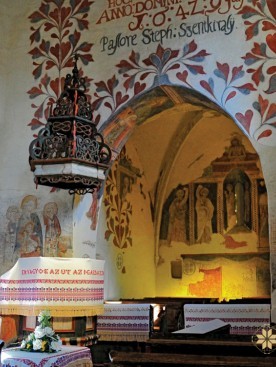The Calvinist Church – CsarodaThe church in Csaroda, built in Late Romanesque style is the most beautifully shining jewel of the Route of Medieval Churches. One of the symbols of the Bereg region is a slender tower ending in a needle-sharp spire, which strives towards the sky. This architectural element is a decoration belonging to the church erected on the flood-plains of the small river Csaroda. This church is one of the most widely known medieval monuments in Hungary. By virtue of its classical division; the unity of the tower, the nave and the sanctuary; the delicately balanced proportions of these three structural elements, this place of worship is an exquisite representative of medieval Hungarian architecture. The literature on Hungarian monuments started discussing Csaroda in the 1950s and since then this church has been considered a classic example for the rural churches built during the period of the Árpád-dynasty. According to earlier opinions, only the tower and the nave were built that early, while the nave stemmed from the 15th century. The archaeological excavations and wall explorations that started in 1971 proved though that the sanctuary and its vaulted ceiling have the same age as the nave. Hence, the church was built between the end of the 13th and the beginning of the 14th century. Historical data do not help much in answering the various questions. The village was named after the small river Csaronda flowing nearby. It was mentioned for the first time in 1311 as a large group of noblemen attacked and destroyed the settlement. By the end of the 13th century, however, the village certainly had a church, since its priest was mentioned in 1299. In the following period, the patrons of the church were the members of the Csarnavodai family. This situation lasted until 1595 when the patron’s rights were transferred to the CalvinistChurch. No major modifications had been undertaken for centuries. However, the medieval mural paintings were covered with lime coating in 1642, and later the walls were decorated both on the outside and the inside with floral motifs. The furniture and the wooden ceiling were renewed in the 18th century. The present church is composed of two parts: a rectangular nave and a square-based sanctuary. On the top of the sanctuary’s southern wall, there is a cornice decorated with saw-teeth. Twin windows cut through the walls of the tower; the ones on the lower level are double, while the ones on the upper level triple. On the southern wall of the nave, one can see three windows spanned by semi-circular arches, while the portal spanned by an archivolt is located on the western wall. The gable above the archivolt is triangular. The chancel arch dividing the inner space of the church in two parts is a lancet arch. A ribbed groin vault ceiling covers the sanctuary. In what concerns early medieval mural paintings, some depictions have been preserved on the northern wall of the nave and the chancel arch. In our opinion, these stem from the beginning of the 14th century. The murals in the sanctuary are stemming from the end of the same century. The inner space of the church is spectacular, since the form and colours characterising various periods create harmony. On the northern and eastern walls of the nave we can see murals that are as old as the church itself: among others the apostles Peter, Paul and John; Saint Anne and The Holy Mary with the baby Jesus on her lap; and the sanctified physicians, that is, the Saints Cosmas and Damianos. The sanctuary has been decorated at the end of the 14th century with frescoes. The side- walls used to depict the twelve apostles, however, one can only distinguish now the figures of Andrew, John, Peter, Thomas, Bartholomew and Simon (the Zealot). In the archivolt of the eastern window, one can see frescoes created during the reign of Sigismund of Luxemburg. These show Saint Dorothy and Saint Catherine of Alexandria, above them Christ ‘The Man of Sorrows’ and, finally, on the vault’s cornerstone Agnus Dei, that is, The Lamb of God. After the middle of the 16th century, the Calvinist took possession of the Church and they covered all medieval mural paintings with lime coating, replacing them with rustic floral motifs, which have been preserved on the external frontispiece, too. The painted wooden ceiling was completed in 1777. The painted wooden pulpit, the gallery and the benches – reminding the observer of the Rustic Baroque style – are roughly as old as the ceiling. Finally, we must also mention the epitaph of count Ferenc Rhédey stemming from 1758. |











